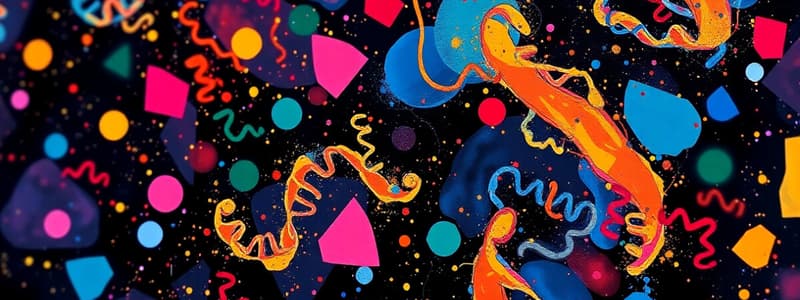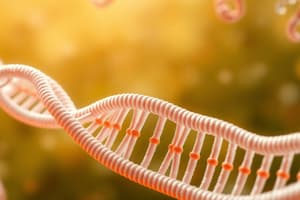Podcast
Questions and Answers
What is the primary advantage of operons in small genomes?
What is the primary advantage of operons in small genomes?
- Increased selection for operons (correct)
- Increased mutation rates
- Increased genetic diversity
- Decreased gene expression efficiency
Superoperons are cotranscribed and may share regulatory regions.
Superoperons are cotranscribed and may share regulatory regions.
False (B)
What is the term for the concentrated sites in the nucleoid where multiple active RNA polymerases are located?
What is the term for the concentrated sites in the nucleoid where multiple active RNA polymerases are located?
transcription factories
Bacterial genes are organized into ________, which group together in superoperons.
Bacterial genes are organized into ________, which group together in superoperons.
Match the terms with their descriptions:
Match the terms with their descriptions:
What is the role of the sigma factor in prokaryotic transcription?
What is the role of the sigma factor in prokaryotic transcription?
The elongation complex is formed before the open promoter complex.
The elongation complex is formed before the open promoter complex.
What is the composition of the catalytic core of the bacterial RNA polymerase holoenzyme?
What is the composition of the catalytic core of the bacterial RNA polymerase holoenzyme?
During transcription elongation, the _____ ions catalyze the chemical reaction of the RNA chain with nucleoside triphosphate.
During transcription elongation, the _____ ions catalyze the chemical reaction of the RNA chain with nucleoside triphosphate.
Match the following steps of transcription elongation with their descriptions:
Match the following steps of transcription elongation with their descriptions:
Flashcards
Operons in Prokaryotes
Operons in Prokaryotes
Groups of genes that are physically close together in the genome, co-transcribed, co-regulated, and associated with a similar function or protein complex.
Superoperons
Superoperons
Clusters of operons that are closely located in the genome, but are NOT co-transcribed; they may share regulatory elements.
Co-transcribed
Co-transcribed
Genes that are transcribed together into a single mRNA molecule.
Co-regulated
Co-regulated
Signup and view all the flashcards
Transcription Factory (Model)
Transcription Factory (Model)
Signup and view all the flashcards
RNA polymerase holoenzyme
RNA polymerase holoenzyme
Signup and view all the flashcards
Open promoter complex (RPo)
Open promoter complex (RPo)
Signup and view all the flashcards
Transcription initiation
Transcription initiation
Signup and view all the flashcards
Transcription elongation
Transcription elongation
Signup and view all the flashcards
Elongation complex
Elongation complex
Signup and view all the flashcards
Study Notes
Module 3: Transcription and post-transcriptional modifications
- Module Name: Transcription and post-transcriptional modifications
- Course Code: 21BBT301
- Course Name: Molecular Biology
- Module: 3
- Course Coordinator: Contact information not provided
- Objective/Learning Outcome: Understand the central dogma of molecular biology (DNA replication, transcription, and translation) and learn the regulation of gene expression in prokaryotes and eukaryotes.
- Syllabus: Covers the fine structure of prokaryotic and eukaryotic genes, function of promoters in mRNA, rRNA, and tRNA genes, RNA polymerases in prokaryotes and eukaryotes, transcription of mRNA, rRNA, and tRNA in prokaryotes and eukaryotes post-transcriptional mRNA processing (capping, splicing, polyadenylation, and RNA editing).
- Gene: A part of DNA where a specific sequence determines function.
- Genome: The complete set of genes or genetic material present in an organism.
- Genome (Prokaryotes): Is usually small, compact, and lacks many regulatory functions.
- Genome (Eukaryotes): Is larger with more complex genetic networks, allowing greater versatility and less isolation.
- Open Reading Frames (ORFs): Spans of DNA sequence between start and stop codons.
- Operon: A functioning unit of DNA that contains a cluster of genes under the control of a single promoter.
- Riboswitch: A regulatory segment of mRNA that binds a small molecule, affecting protein production.
- Transcription factor (TF): A protein that controls the transcription of genetic information from DNA to mRNA.
- Enhancer: A short DNA region bound by proteins (activators) to increase the likelihood of transcription.
- Repressor: A DNA or RNA binding protein that inhibits gene expression.
- Silencer: A DNA sequence that binds transcription regulation factors (repressors).
- Promoter: A DNA sequence where proteins bind to initiate transcription.
- Regulatory sequence: A segment of DNA capable of increasing or decreasing the expression of specific genes.
- Fine structure of prokaryotic genome: Lacks clear physical separation between DNA and cytoplasm. High rates of horizontal gene transfer and gene loss. Genome replication, segregation, and cell doubling are tightly linked. Transcription, translation, and protein localization are tightly linked and nascent transcripts are immediately translated.
- Fine structure of prokaryotic genome (cont.): Cells endure intense gene expression. Rapid replication fork and RNA polymerase collisions are frequent. SOS or SOS-like responses may trigger the transfer of mobile genetic elements.
- Polyploidy (prokaryotes): Multiple copies of replicons (chromosomes) confer advantages, like wider gene expression in large cells. It allows for heterozygosity; ratio between replicons allows regulation. Also enables repair by homologous recombination and gene conversion.
- Polyploidy (prokaryotes, cont.): Organization of prokaryotic genomes—replicons are typically located near opposite poles (Ori and Ter) in circular replicons. Replication forks complete replication synchronously.
- Promoter elements (prokaryotes): -10 and -35 regions are key. -10 region contains TATAAT, -35 region contains TTGACA. -65 to -60 activator elements activate the polymerase, while -200 to -1000 enhancer sequence enhances transcription by 100-200fold.
- Operons in prokaryotic genomes: The majority of prokaryotic genes are expressed in the form of operons, polycistronic units, usually encoding proteins in a common pathway. Operon organization allows for coordinated expression of genes in the same pathway.
- Operons in prokaryotic genomes (cont.): Genes grouped in operons share similar expression rates. Large genomes have many more different transcription factors.
- RNA polymerase (prokaryotes): One core enzyme, with two alpha, one beta, one beta prime, and one sigma subunit. The core enzyme polymerizes RNA. The sigma factor helps the holoenzyme find initiation sites.
- RNA polymerase (eukaryotes): Multiple types: I, II, and III. Polymerases are larger and more complex (containing more subunits) than in prokaryotes. Different polymerases transcribe different types of RNA.
- Eukaryotic transcription regulatory factors: Additional factors (enhancers and silencers) regulate the efficiency of transcription. Many basal factors (proteins) are needed in the pre-initiation complex (TFIIA, TFIIB, TFIIE, TFIIH etc).
- Eukaryotic promoters: Usually larger and more complex than prokaryotic promoters; often contain a TATA box (like TATAAAA).
- Eukaryotic gene structure: Introns are removed
- Poly(A) tail: Added to the 3' end of pre-mRNAs, contributing to mRNA stability, translation, and nuclear export.
- RNA splicing: Removal of introns and joining of exons, generating mature mRNA. A spliceosome complex forms.
- Differences between prokaryotic and eukaryotic transcription and translation: The general process of mRNA synthesis is similar, but differences exist in the structure, location, and regulation of the systems.
Studying That Suits You
Use AI to generate personalized quizzes and flashcards to suit your learning preferences.
Related Documents
Description
Dive into the intricacies of transcription and post-transcriptional modifications in Molecular Biology. This module explores the central dogma encompassing DNA replication, transcription, and translation, while also focusing on the regulation of gene expression across prokaryotes and eukaryotes. Master the functions of promoters and the various forms of RNA processing essential for gene expression.




